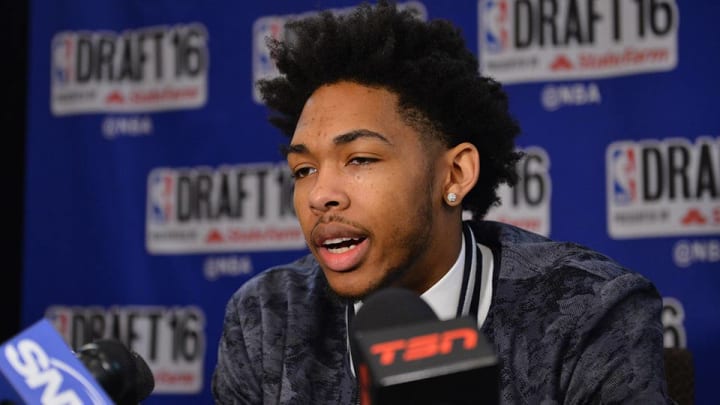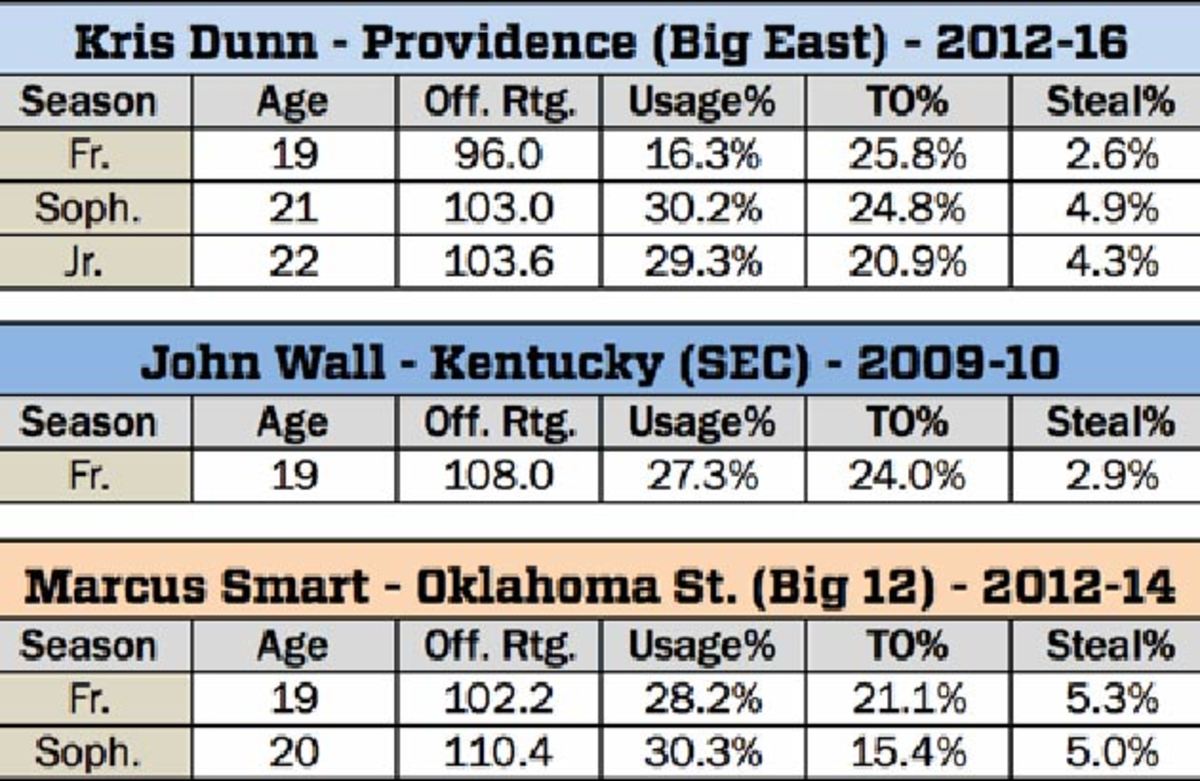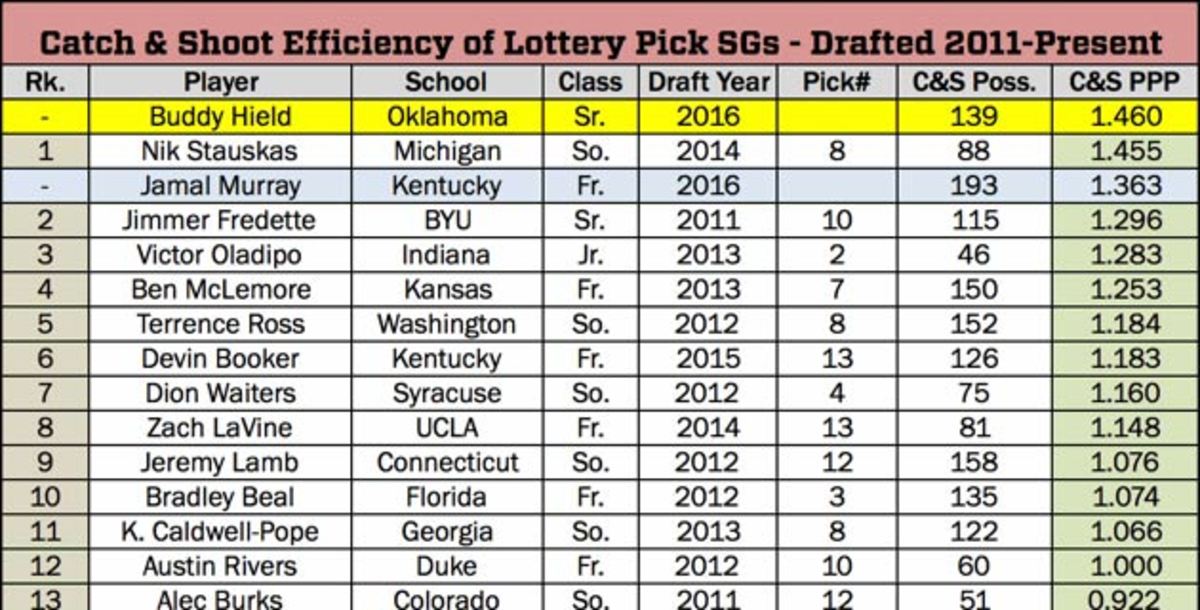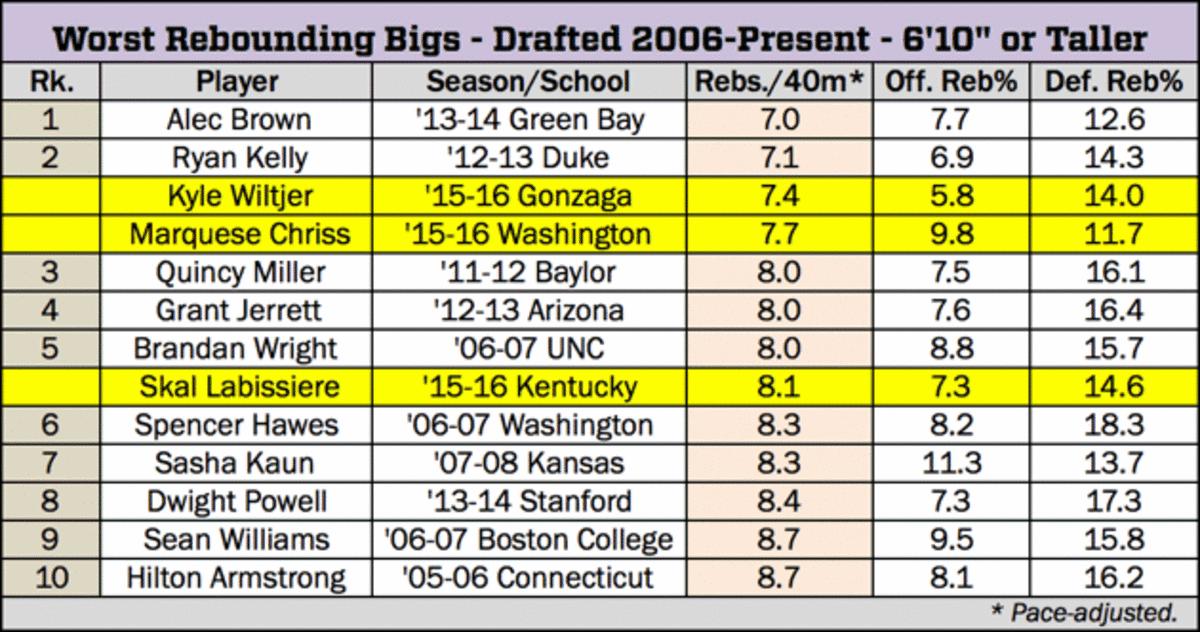NBA draft notebook: Draft's top guard, sleepers, beware of Chriss and more

Your teams. Your favorite writers. Wherever you want them. Personalize SI with our new App. Install on iOS or Android.
Ten thoughts (and seven charts) on the eve of the 2016 NBA draft...
1. The odds are getting better and better that Providence's Kris Dunn will be the first guard taken in this draft —either at No. 3 by the Celtics, or at No. 3 by whomever trades for the Celtics' pick. Dunn passes the eye test; he's 6'4" with a 6'9" wingspan, and he has the athleticism to defend NBA point guards. He's been regarded as a sort of John Wall Lite, due to the similarities in proportions and explosiveness. But I'm skeptical that Dunn will come near the ceiling that the most bullish, eye-test scouting reports project.
• NBA Draft Big Board 4.0: Final rankings of the top 60 prospects
His college stats—particularly his high turnover rates, and mediocre shooting on free throws and twos—suggest that he has serious offensive limitations. Even as a 22-year-old junior in the Big East, Dunn was a less efficient point guard than a 19-year-old Wall was in the SEC. Or if you want to compare Dunn to a guy he might compete with for playing time in Boston: He was less efficient as a 22-year-old junior at Providence than Marcus Smart was as a 20-year-old sophomore at Oklahoma State. And Smart's own offensive limitations are likely to keep him from ever becoming a star in the NBA.

Dunn might be the first guard taken, but I'd bet on someone else becoming the most valuable guard in this draft.
•The case for Brandon Ingram as the No. 1 pick in the 2016 draft
2. The best two candidates to go ahead of Dunn are Jamal Murray or Oklahoma's Buddy Hield, with Hield being the safest play due to his obvious fit as a scoring two-guard and absurd work ethic. Hield took a while to master his shooting form, but he needs to be cut some slack for that, as he didn't leave the Bahamas for the U.S. until 2010. Once it was picture-perfect this season, his catch-and-shoot numbers were phenomenal. According to Synergy Sports Technology, Hield was a more efficient catch-and-shoot guy, in his draft year, than any of the Lottery Pick shooting guards since 2011:

3. One reason Oregon State's Gary Payton II could be a second-round sleeper: He offers the rare combination of big rebounding numbers and a high steal rate from a major-conference floor general. Those were numbers that served former prospects Rajon Rondo and Iman Shumpert well—and Payton actually grabbed more boards per 40 minutes (9.3) than any major-conference point guard who was picked in the past 10 drafts. There may be a niche for Payton as a defensive-minded backup in the NBA.


5. There's also a sizable crop of college big men who didn't move the ball. Of the power forwards and centers that are likely to be drafted, five averaged fewer than 1.5 assists per 40 minutes, pace-adjusted. Chriss makes an appearance here, too, but Maryland's Diamond Stone is the chief offender, averaging 0.7 assists per 40—and just one assist per 25 possessions used:

•Special Delivery: Will Dragan Bender be the NBA's next Croatian star?
6. Multiple teams in the 3-7 range of the lottery are seriously considering Chriss over Euro import Dragan Bender if they choose to go the stretch-four route. I think that's a mistake, given Chriss's alarmingly low rebound and assist numbers, and Bender's elite passing ability. Although Bender didn't get to showcase that passing with Maccabi Tel Aviv, he did thrive as a playmaker for the Croatian national team at the European Under-18 championships in 2014. At that tournament in Turkey, Bender posted the highest rate of assists per 40 minutes and best assist-turnover ratio of any big man in DraftExpress' 20-year Euro U18 database. And Bender was just 16 at the time, playing against 17- and 18-year-olds—including Lithuania's Domantas Sabonis, a fine passer in his own right, and a likely top-15 pick Thursday.

7. This is a draft pool that's better viewed on an age spectrum than a college-class spectrum:

All one-and-doners are not on the same path, and it's worth reminding that almost-certain No. 1 pick Ben Simmons is closer in age to sophomores Wade Baldwin IV, Domantas Sabonis and Jakob Poeltl than Simmons is to fellow freshman Brandon Ingram or Dragan Bender. Bender and Ingram should be regarded in a separate young'uns club that may need a year or two of seasoning to physically catch up to Simmons—but when that happens, either one could end up being a better NBA player than the Aussie hybrid forward. Viewing Kentucky's Skal Labissiere and Syracuse's Malachi Richardson this way—as freshmen who are older than some sophomores—makes me even more alarmed about their limited production in '15-16.
• Mock Draft Roundtable: Projecting the first 30 picks of the 2016 NBA draft
8. My best value picks, if the mock drafts hold up: Ingram at No. 2, Hield in the 5-7 range, Bender in the 5-7 range, Murray in the 5-7 range, Michigan State's Denzel Valentine in the 20s.
9. Biggest over-reaches, if the mock drafts hold up: Chriss at 3-4, Jaylen Brown at 6-9, Labissiere at 10-13, Vanderbilt's Damian Jones in the late 20s.
10. Best second–round sleeper values: Virginia's Malcolm Brogdon, who can be a three-and-D wing, and Michigan's Caris LeVert, who when healthy was one of the nation's most efficient combo guards. And if he goes undrafted, Wichita State's Fred VanVleet would be one of my first calls to put on a summer league roster in need of a point guard. I get that he's undersized, but he was one of the college game's best leaders, a high-impact defender, and a smart, patient pick-and-roll playmaker. He made bigger schools regret overlooking him coming out high school, and he just might fight his way onto an NBA roster.
Statistics in this column are from kenpom.com, DraftExpress.com and basketball-reference.com.
